Kibbutz Lotan Israel
An oasis in the desert
by Alex Cicelsky
The long journey through the desert to Kibbutz Lotan is stunning as the road meanders through millennia-old rock formations. We live in one of the hottest and driest deserts on earth. The physical site that was chosen was secondary to the common vision we held, of building a community where we would work together for the common good, and would have equal opportunity to realize our potential. We had a lot of time to talk about our ideals, because it took four years from when we started as a group until we moved into our houses. That long wait was probably good considering we were all 18 years old when the decision was made to start the kibbutz!
When I give tours I point out a number of things that are not obvious, as we walk on tree shaded paths, past experimental solar-powered straw bale houses. The first is that we did not start as an ecovillage; we began as an intentional socialistic community with egalitarian Jewish values, sponsored by the 100-year-old Kibbutz Movement. Kibbutzim were built in cooperation with the Israeli government to establish agriculture and industry in the country’s periphery. Most land in Israel is owned collectively by its citizens, (as are all water resources) so we pay rent. Our houses, buildings, infrastructure and agricultural machinery were supplied by the government on long-term loans, which we repay. We, the young adults that founded the community, chose to be members of the commune where we’d all work the land, share our income (and pay our debts) and develop a spiritually motivated society. What drew me into this adventure was both the physical and ideological aspects. With the guidance of advisors from neighbouring Kibbutzim, we changed from city dwellers to hard working farmers, carrying box upon box of vegetables out of our fields of pure sand. We harvested dates from the trees we planted and everything was irrigated with brackish water. The work in establishing our economic base from agriculture was physically very hard, and not always economically successful. The ‘back to the land’ ethic is measured in its ability to pay at least for food, water, health care, housing, supplies and machinery. We spent many hours in committee meetings, and at-large community meetings discussing the income of our communal business. We also spent considerable time considering the values of our society.
Our community was unique in Israel because we decided to meld the rather strict and secular structure of socialism, with the egalitarian and pluralistic interpretation of Liberal-Reform Judaism.
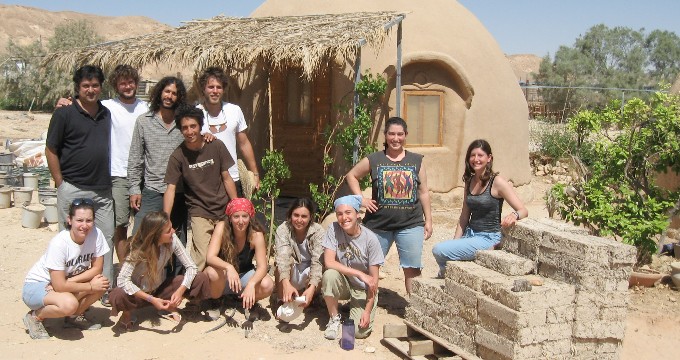
Green Apprenticeship Permaculture course students.
Caring for people and appreciating nature
Most of us came from Jewish homes with various levels of religious practice, so we all had unique cultural gifts to bring to the group. We celebrate Shabbat (the Sabbath) every week and holidays throughout the year with creative prayer, music, foods, and a diversity of traditions from our families and their heritages from around the world. We put great effort into making holidays fun and meaningful. And we make a concerted effort so that Shabbat and holidays are time for physical rest and spiritual renewal. Shabbat and holidays begin at sunset and end the next day when three stars appear in the night sky. During this time there is no formal work, with the exception of milking and feeding the cows, and community food service in the dining hall. In addition to not working it is taboo to speak about making money or labour. The result is calmness and time for connecting with each other and nature. As our knowledge of farming grew, so did our understanding of the connections between agriculture and the seasonal patterns of the Jewish holidays. We deliberately incorporated these connections into our holiday celebrations, making the celebrations much more meaningful to the lives we were living. Judaism is based on commandments of caring for people and appreciating nature. Combining a farming life that depends on nature with Jewish values had a profound impact on those of us that had studied ecology, clean technologies and organic agriculture. This, for me, was a paradigm that catalysed a need to add the dimension of ‘eco’ into our village.
To our community’s credit we always valued sharing of resources and had from the beginning many ecovillage practices. Our few cars are collectively owned and to use a car I have to sign up on a board in the office, including where I’m going, so that others can join me. The communal dining hall serves three healthy meals a day, meat is served only five times a week. Almost all of the food served in the dining hall is “home made” from locally sourced produce. All of our houses are small and children play all over without regard to whose property it is. We rotate positions of leadership and have a direct democracy, with long processes to reach close-to-consensus decisions. We live frugally both by choice and because we have very limited income. We love the desert around us and work to protect it.
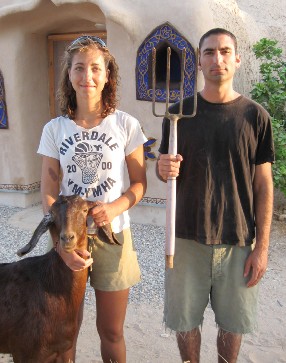
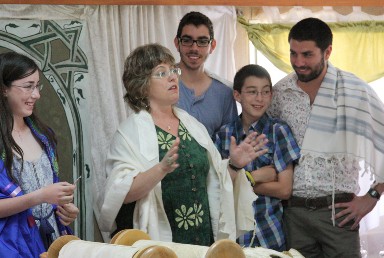
Eden’s bat mitzvah.
An educational demonstration center
In 1996 a few of us decided to start work on a research, development and education centre that would address a wide gamut of environmental issues and would affect change in our community and throughout the country.
Not only was the scope of the change we envisioned daunting, but the resistance to change from our fellow community members was significant. Many community members were concerned that these changes would demand more work (we’re always understaffed) and investments that we could not afford. One issue was that none of our pre-fab concrete houses were appropriate for our climate. In the winter the walls of the buildings are 12°C and during the 5 month long summer the air temperature is 30-45°C. There was no recycling at all in the country. Conventional agriculture paid the bills. Nevertheless we set our sights on what we felt needed to change.

We spent four years learning, taking our first actions and making educational mistakes. Our list of changes included community-wide separating and recycling of waste, developing organic and chemical free agriculture, developing energy-efficient building systems based on natural materials, developing renewable energy production, reducing water usage and increasing wastewater recycling, protecting migratory birds, and starting an educational demonstration centre so that we can change our region and the country. Slowly the community came to love what we were doing, and wanted to participate in the projects. In 2000 we established the Centre for Creative Ecology (CfCE) which has had a tremendous impact on the community and the region. Our work was recognized and applauded by our Regional Authority, the Ministry of Agriculture and the Ministry for Environmental Protection for voluntarily taking action to reduce our waste by over 70% and for serving as an inspiration to other communities in the region and the country. We were in the news because we composted our organic waste and turned the refuse that doesn’t decompose into a Noah’s Ark playground, bird watching hides and the community bus stop. The creative work was done by community members, mud-covered kids and participants in our Green Apprenticeship Permaculture Design Course. This recognition and support inspired us to continue our research, development and education work.
The most magical place on Kibbutz Lotan is where we teach organic farming, soil care, nature conservation and sustainable development. The organic garden, Israel’s first CSA (Community Supported Agriculture), is nothing less than a miracle. The southern Arava desert is one of the hottest and driest on the planet. Growing organic vegetables in pure sand, without industrial fertilizers, pesticides or herbicides, was considered pure folly by agricultural advisors. Years of building soil and using composted waste from the communal kitchen and the dairy, has created a bountiful garden. A large and diverse collection of vegetables, herbs, fruit trees and flowers are home to increasing populations of insects, butterflies and bees. Each year, birdwatchers from around the world flock to the garden, which is a resting and feeding place for hundreds of varieties of migratory birds each fall and spring.
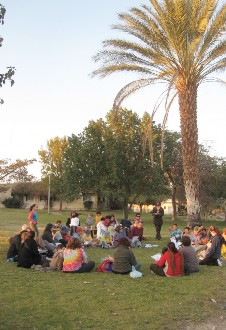
Tu B’shvat creative service.
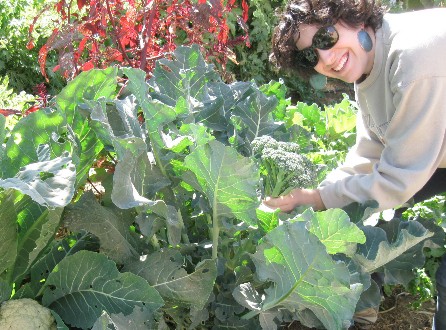
Harvesting vegetables.
Natural building
The Eco Campus is the solar-powered neighbourhood where our students live and learn. It has 10 earth plastered straw bale ‘dome-atories’. These experimental buildings, constructed by the students, are earthquake resistant due to an interior, handcrafted geodesic steel pipe frame, and may be the most energy efficient buildings in the country. They use about 70% less energy to heat and cool than conventional buildings. These prototypes are teaching us how we can retrofit existing buildings and build new houses for new members of our community.
Outreach, education and eco-tourism
EcoKef (‘kef’ is ‘fun’ in Hebrew and Arabic) is our hands-on learning park where thousands of visitors each year see the feasibility of sustainable desert agriculture, natural construction and water treatment and renewable energy options. The sole acacia tree that lived here before we arrived is now surrounded by olives, figs, marula, moringa, and thousands of date palms producing what are considered some of the best Medjool dates in the world. The water used for all the trees is brackish ground water unfit for human consumption. We also have an orchard irrigated with treated wastewater from the city of Eilat. We ran the first EDEs (Ecovillage Design Education courses) in the world. In addition to our Permaculture courses, we host the southern branch of the Arava International Centre for Agriculture Training. Fifty college students from southeast Asia get weekly instruction in advanced agriculture and Permaculture, and we run seminars for Israel’s Agency for International Development Cooperation and for university groups from around the world. Students and visitors of the CfCE have the opportunity to meld with the Kibbutz Lotan community and have a first-hand experience of intentional community life, community celebrations and engagement in protecting the environment. We have renovated 22 apartments into guest accommodation. Our strawbale Solar Organic Tea House is the first grid-connected solar restaurant in the country and has no-complaint composting toilets.
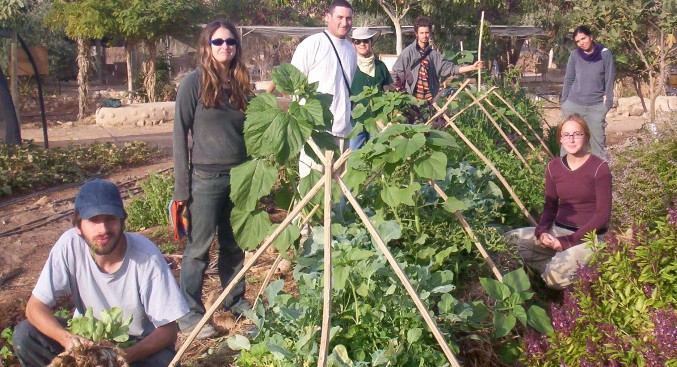
Sheet mulched garden doing well.
Spirituality, community celebration
Kibbutz Lotan is one of the first communities in Israel where liberal, egalitarian Judaism is practised. I think that ours is ‘a Jewish expression of the Universal belief’ of spirituality, social justice and earth-care. Our ceremonies are full of song and poetry which resonate with people of different faiths and spiritual practises.
Doing beautiful things together
I love Tu B’shvat—the New Year of the Trees—which is the day in the early spring that was used in ancient times for calculating tithes. Today it is a nationwide day of planting trees. When driving home I stop at the overlook and think about all of the years of planting these trees that has resulted in Lotan appearing like a green island in a sea of sand. I think our community’s favourite holiday is the Fall Harvest Festival of Sukkot when we spend the week living outdoors in makeshift huts with roofs of palm branches. It is a tradition from Biblical times to remember the travels out of Egypt and slavery, through the desert and into the land of freedom and abundance. Today we see it is a reminder that we are sojourners, temporarily on this Earth and dependent upon her. It is with this sense of responsibility to the Earth that we balance the development of our community, our use of resources and protecting the environment around us. It is also an opportunity to do beautiful things together.
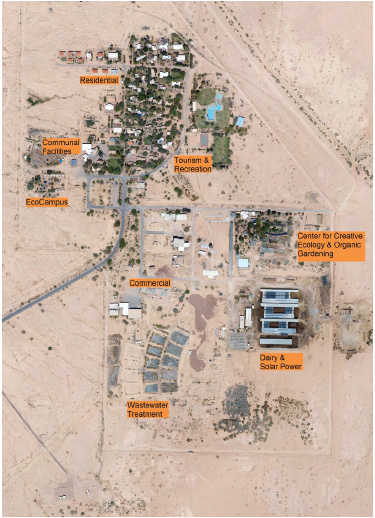
Aerial photo of the EcoKef.
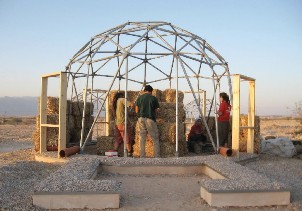
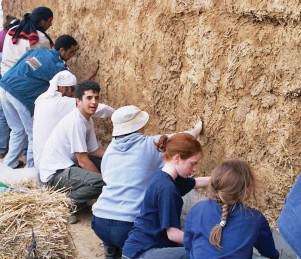
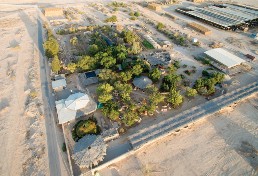

Dome construction and clay building.
Location: In the southern Arava valley of Israel and Jordan, Southern Israel.
Established: 1983
Area: 62 ha (153 ac) zoned for residential and commercial use. In addition, there are 178 ha (440 ac) of fields and date palm plantations.
Population: In total 200 people. With 30 families of members: 60 adults and 60 children. In addition: families of refugees, 18-year-old Israelis in a ‘year of service and leadership’, volunteers from around the world, Centre for Creative Ecology interns, 15-20 Green Apprenticeship Permaculture students.
Common facilities: Community Centre, Seminar Centre, Bar and Cinema, Dance-Hall, workshops, Forest kindergarden, farm and more.
